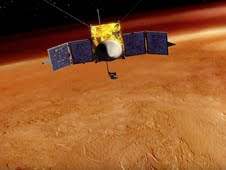
NASA's mission to investigate the mystery of how Mars lost much of its atmosphere passed a critical milestone on October 4, 2010. NASA has given approval for the development and 2013 launch of the Mars Atmosphere and Volatile Evolution (MAVEN) mission. Clues on the Martian surface, such as features resembling dry riverbeds and minerals that only form in the presence of liquid water, suggest that Mars once had a denser atmosphere, which supported the presence of liquid water on the surface. As part of a dramatic climate change, most of the Martian atmosphere was lost. MAVEN will make definitive scientific measurements of present-day atmospheric loss that will offer insight into the Red Planet's history. This project is a vital complement to past, present, and future Mars missions. MAVEN will take us a step closer in learning about the evolution of our intriguing celestial neighbor.”
NASA Goddard will manage the project, which will cost $438 million excluding the separately government-furnished launch vehicle and telecommunications relay package. Goddard will also build some of the instruments for the mission. In addition to the PI coming from CU-LASP, the university will provide science operations, build instruments, and lead Education/Public Outreach. Lockheed Martin of Littleton, Colo., will build the spacecraft based on designs from NASA's Mars Reconnaissance Orbiter and 2001 Mars Odyssey missions and perform mission operations. The University of California-Berkeley Space Sciences Laboratory will also build instruments for the mission. NASA’s Jet Propulsion Laboratory, Pasadena, Calif., will provide navigation support, the Deep Space Network, and the Electra telecommunications relay hardware and operations.








No comments:
Post a Comment